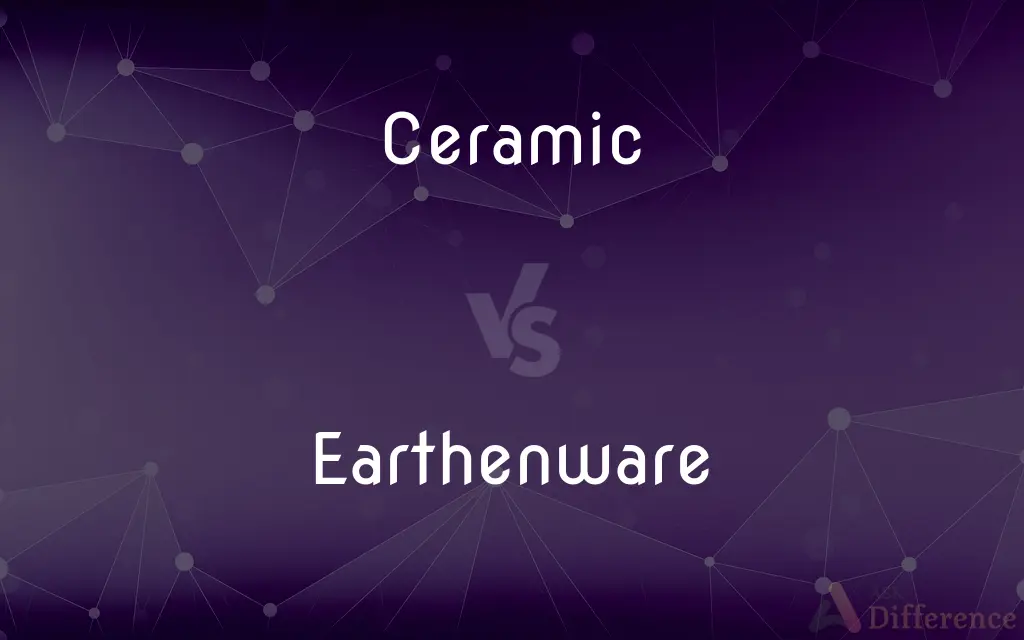Ceramic vs. Earthenware — What's the Difference?
By Urooj Arif & Maham Liaqat — Updated on March 7, 2024
Ceramic is a broad category of materials that are hardened by heat, while earthenware is a specific type of ceramic that is porous and not as strong.

Difference Between Ceramic and Earthenware
Table of Contents
ADVERTISEMENT
Key Differences
Ceramic encompasses a wide range of inorganic, non-metallic materials that are hardened by heat. These materials can be composed of clay, minerals, and can vary significantly in terms of strength, density, and durability. Earthenware, on the other hand, is a specific type of ceramic that is made from clay fired at relatively low temperatures (usually between 1000°C and 1150°C).
The aesthetic qualities of ceramics can vary widely, with some being highly polished and translucent, like fine porcelain, while others, like earthenware, often have a more earthy, rustic appearance. This is due to the differences in the materials used and the firing temperatures, which affect the texture, color, and overall look of the final product.
Earthenware's lower firing temperature means it can be easier to work with than some other ceramics, allowing for more intricate shapes and designs. This makes it particularly popular for artistic and decorative items. However, its lower strength and porosity limit its use in applications requiring high durability or impermeability.
Earthenware typically offers a more economical option due to its lower firing temperatures and the abundance of suitable clays. This, combined with its aesthetic appeal, makes it a favored choice for craft potters and ceramic artists. In contrast, other ceramics, including some types of porcelain, require more specialized materials and higher temperatures, leading to increased production costs.
Comparison Chart
Composition
Wide range of inorganic, non-metallic materials
Clay, fired at lower temperatures
ADVERTISEMENT
Strength
Varies; can be very strong
Generally weaker and porous
Firing Temperature
Varies; can be very high
Lower (1000°C - 1150°C)
Aesthetics
Wide range; can be polished and translucent
Often earthy and rustic
Uses
Broad (tableware, aerospace, etc.)
Decorative items, plant pots, rustic tableware
Compare with Definitions
Ceramic
Can range from fine porcelain to rugged stoneware.
Ceramic tiles can vary widely in texture and durability.
Earthenware
Characterized by an earthy appearance.
The earthenware pieces add a warm, organic feel to the kitchen.
Ceramic
Depends on composition and firing temperature.
High-fired ceramic is exceptionally strong and water-resistant.
Earthenware
Popular for artistic and decorative items.
Earthenware vases are a favorite among artisans for their texture and color.
Ceramic
Inorganic, non-metallic materials hardened by heat.
The vase is made from ceramic, known for its durability.
Earthenware
Naturally porous, often glazed for waterproofing.
Glazed earthenware is commonly used for decorative dishware.
Ceramic
Can be highly polished or have a matte finish.
The ceramic sculpture had a glossy finish that caught the light beautifully.
Earthenware
Less strong and durable than other ceramics.
Earthenware is more prone to chipping and wear over time.
Ceramic
From household items to advanced industrial applications.
Ceramic components are crucial in the manufacturing of electronic devices.
Earthenware
A type of ceramic made from clay, fired at lower temperatures.
The earthenware pot has a natural, rustic charm.
Ceramic
A ceramic is any of the various hard, brittle, heat-resistant and corrosion-resistant materials made by shaping and then firing a nonmetallic mineral, such as clay, at a high temperature. Common examples are earthenware, porcelain, and brick.
Earthenware
Earthenware is glazed or unglazed nonvitreous pottery that has normally been fired below 1,200 °C (2,190 °F). Basic earthenware, often called terracotta, absorbs liquids such as water.
Ceramic
Made of clay and permanently hardened by heat
A ceramic bowl
Earthenware
Pottery made of clay fired to a porous state which can be made impervious to liquids by the use of a glaze
An earthenware jug
Ceramic
Pots and other articles made from clay hardened by heat
Many of the painted ceramics are of native manufacture
Earthenware
Pottery made from a porous clay that is fired at relatively low temperatures. Faience, delft, and majolica are examples of earthenware.
Ceramic
Any of various hard, brittle, heat-resistant and corrosion-resistant materials made by shaping and then firing a nonmetallic mineral, such as clay, at a high temperature.
Earthenware
An opaque, semi-porous ceramic made from clay and other compounds.
Earthenware bowl
Ceramic
An object, such as earthenware, porcelain, or tile, made of ceramic.
Earthenware
Vessels and other utensils, ornaments, or the like, made of baked clay. See Crockery, Pottery, Stoneware, and Porcelain.
Ceramic
Ceramics (used with a sing. verb) The art or technique of making objects of ceramic, especially from fired clay.
Earthenware
Ceramic ware made of porous clay fired at low heat
Ceramic
Made of material produced by the high-temperature firing of inorganic, nonmetallic rocks and minerals.
A ceramic vase stood on the table.
Ceramic
(uncountable) A hard, brittle, inorganic, nonmetallic material, usually made from a material, such as clay, then firing it at a high tempature.
Joan made the dish from ceramic.
Ceramic
(countable) An object made of this material
Joe had dozens of ceramics in his apartment.
Ceramic
Of or pertaining to pottery; relating to the art of making earthenware; as, ceramic products; ceramic ornaments for ceilings.
Ceramic
An artifact made of hard brittle material produced from nonmetallic minerals by firing at high temperatures
Ceramic
Of or relating to or made from a ceramic;
A ceramic dish
Common Curiosities
What is earthenware?
Earthenware is a type of ceramic made from clay and fired at lower temperatures, resulting in a porous material that is often glazed to increase durability.
Is ceramic dishwasher safe?
It depends on the type and the glaze; many ceramics are dishwasher safe, but it's best to check the manufacturer's recommendations.
How does earthenware differ from other ceramics?
Earthenware is fired at lower temperatures, making it more porous and less durable than other ceramics like porcelain and stoneware.
Can earthenware be used for cooking?
Yes, but it must be glazed to make it waterproof and suitable for cooking; however, it is less durable than other types of cookware.
How can I tell if a piece is earthenware?
Earthenware typically has a thicker, more rustic appearance than finer ceramics and may be more opaque.
Why choose earthenware over other ceramics?
Earthenware offers a rustic aesthetic and is often more affordable, making it a popular choice for decorative items.
Does the color of ceramic affect its durability?
No, the color of a ceramic piece does not typically affect its durability; this is more closely related to the material composition and firing temperature.
What is ceramic?
Ceramic is a broad category of inorganic and non-metallic materials that are hardened by heat, offering a range of properties based on composition and firing temperature.
Can ceramic be recycled?
Yes, ceramic can be recycled, though the process is more complex than recycling glass or metal and often involves crushing and repurposing the material.
Can earthenware be repaired if it breaks?
Yes, it can often be repaired with adhesives designed for ceramics, though the repair may be visible.
Is earthenware eco-friendly?
Earthenware can be considered eco-friendly due to its natural materials and lower firing temperature, which reduces energy consumption.
Can earthenware be microwaved?
Glazed earthenware can often be microwaved, but unglazed or cracked pieces should not be, as they may absorb moisture and become damaged.
Are all ceramics oven safe?
Not all; the safety of ceramics in the oven depends on the type of ceramic and the firing temperature. Earthenware, for instance, may not withstand high oven temperatures.
How do I clean and maintain earthenware?
Earthenware should be cleaned with mild detergent and warm water; avoid using abrasive cleaners to prevent damage to the glaze.
Are there any foods that should not be stored in earthenware?
Foods with high acidity can sometimes wear down the glaze on earthenware, so it's advisable to use it with such foods sparingly.
Share Your Discovery

Previous Comparison
Knob vs. Nob
Next Comparison
Epicaricacy vs. SchadenfreudeAuthor Spotlight
Written by
Urooj ArifUrooj is a skilled content writer at Ask Difference, known for her exceptional ability to simplify complex topics into engaging and informative content. With a passion for research and a flair for clear, concise writing, she consistently delivers articles that resonate with our diverse audience.
Co-written by
Maham Liaqat














































